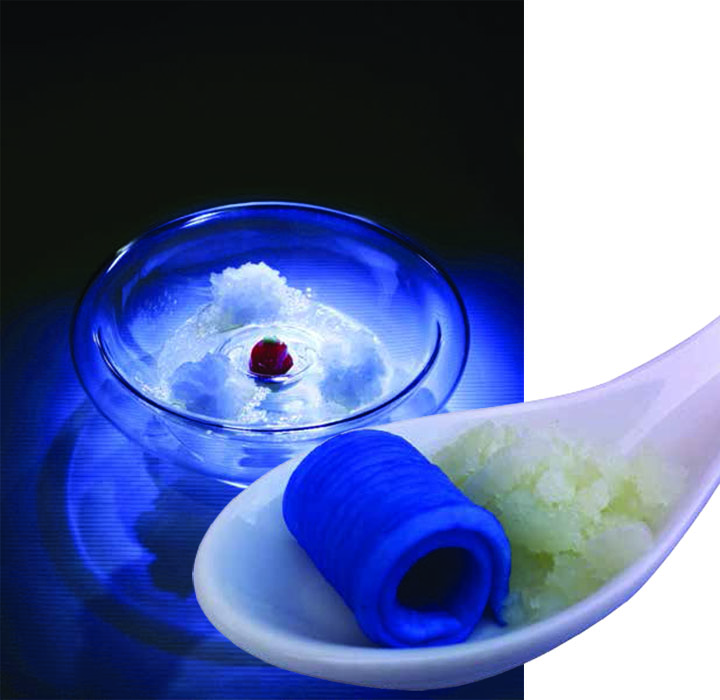Food purists could object to using liquid nitrogen to make ice cream or using amino acids and cellulose instead of meats and vegetables – but sometimes, complex problems need radical solutions: French Physical chemist, Herve’ This, whose main area of scientific research is ‘molecular gastronomy’ (a term he helped coin with Hungarian physicist Nicholas Kurti) has come up with a completely new approach to cooking which aims to reduce food spoilage in a lop-sided world ridden with hunger and obesity.
This morning, I was lecturing for scientists (biologists). I asked them: who came to this place on a horse? Nobody, of course: they had used planes, cars, and trains… Who still writes on the grated skin of an animal using a feather and a black liquid obtained by macerating rusted iron in water with some tree bark? Nobody, of course: they had computers. But who is still eating roasted chickens, or apples, carrots, leeks? Here, there was a difference: everybody! Yes each one of us is still eating as the humankind did centuries, and even millennia ago! Why?
Take another art: music, and just hear at the radio: generally violins and pianos are only on some small programmes, and electro-acoustic music is everywhere, with synthesizers! What a revolution: only 50 years ago, this kind of music was considered futuristic. At that time, it was considered as impossible to make music from pure waves, and it is true that when computers (the first ones) were introduced in music, it took awfully long to build new sounds, timbers, and then music. But with time, researchers turned into simple engineers, and then musicians could do it; now children play with synthesizers that they receive for Xmas!
For colour, it is the same: any child using a computer can make all possible colours using three elementary colours, which are added. Sculpture just had the same advances, with 3D printers. For literature, it’s already decades since computer novels were introduced.
Isn’t it time to move, where food is concerned?
Let’s jump over our fears
Of course, synthetic food is something that upset most people. As primates, we are afflicted with ‘food neo-phobia’, which means that we eat only what we learned to consider as “good”, while we were very young. And this is why we eat our culture: some love Munster cheese, in spite of the very strong smell; others consider delicacy the brain of an almost alive ape whose skull was freshly opened, as a delicacy; others eat snails and frogs; others eat boiled meat with mint sauce; some prefer hamburgers; others want such fruits as durians… We all know perfectly the list of food particularities of the different human groups, and are often intolerant of all those who don’t eat as we do.
Moreover for centuries, it was considered as the utmost futuristic nightmare to eat pills or tablets… We keep going back to the film ‘Soylent Green’, each time a new kind of food is proposed – but lets not forget that the story amalgamates many different ideas : eating dead bodies, totalitarianism, cynical capitalism, death punishment, Malthusianism etc…

More generally, I know by experience that novelty in food is often rejected. For example, molecular cooking was frequently criticized… whereas its ‘definition’ was only “to make food using modern tools”! Forget what you could read, hear or see, and trust me… because I was one of those who introduced molecular cooking, and the one who created the expression “molecular cooking”. The idea behind this, in the 80’s, was only to improve culinary techniques. For example, when you make a meat stock (all chefs do that when they arrive at their restaurant, in the morning), you have to clarify it, which means that you have to: (1) cook it; (2) wait until it’s cold; (3) put it in the fridge until fat solidifies; (4) skim away the solidified fat; (5) whip egg whites and add them to the cold stock; (6) heat again until coagulation of egg whites, trapping impurities; (7) filter through a clean towel folded in four in a sieve; Why not simply use a ‘decanting bulb’ for de-fatting, and then a chemistry filter, to get the stock clear ? It takes seconds instead of hours! This is exactly molecular cooking is – siphons for making foams, liquid nitrogen to make ice creams and sherbets, ultrasonic probes to make emulsions such as mayonnaise.
I remember that, in 1984, when I proposed “new” gelling agents such as agar-agar, carraghenans, alginates, etc. to chefs, the proposal was rejected saying, “you’re smart, but you are going to poison us”! … But in 2000, when the ‘mad cow disease’ struck Europe, chefs dropped gelatine and adopted these gelling agents within a few weeks!
The lesson is clear: I don’t have to take care of fears. Circumstances will do.
‘Note by note’ cooking
Nowadays, molecular cooking is everywhere, as chefs are generally equipped with modern tools, and the next move has to be made, and this new move is called ‘note by note cooking’. The idea is to drop meat, fish, egg, vegetables and fruits, and use instead ‘compounds’. For example water, cellulose, amylose, amylopectine, aminoacids, various organic acids (citric, malic, acetic…), pigments, odorant compounds… Using these compounds, one has to decide for all aspects of dishes: shapes, colours, odors, tastes, and consistencies…
Is it difficult? Remember the story of electro-acoustic music. Today chefs struggle to make such food, but it is only because they want something really good. Using gelatine, water, one pigment, salt or sugar, one odorant acid, a dish can be made (and it is more or less like English jellies). Is it expensive? Here again, it all depends on what you want to make: you could have something cheap with water and oil, but some elaborated note by note dishes made by great “culinary artists” enter in menus costing up to 500 dollars. Is it good? Here the answer is simple: it is generally good when incorporating glucose, saccharides (sugars) and fats, as human beings love these vital nutrients. But trust me to make it “bad” for you, if you are over 20 years old : in order to make ‘note by note’ a lasting trend, I try to give it primarily to young people. And this is why ‘kits’ are now being designed, so that they could be sold in game shops, just as the molecular cooking kits were sold, or as synthesisers are!
Moreover, since I envisioned ‘note by note’ cooking in 1994 (the name was given only in 2004), the strategy of development was: (1) to lecture, in order to explain what it is (this means also media coverage); (2) to show it to the best chefs only; (3) to teach it in technology institutions; (4) to distribute recipes through Internet. Today, food engineers learn it during their studies in some countries (France, Ireland, Portugal) and many French chefs already showed ‘note by note’ dishes, served in various circumstances, such as the launching banquet of the International Year of Chemistry, by UNESCO.
A political project
Why is it so important to develop ‘note by note’ cooking? For sure, the art proposal is exciting, but this new culinary technique is also the key to the development of a different approach to human food. It is well known now, that the 9 billion people who will live on the Earth in 2050 will starve if solutions are not found. And it was well analyzed that a key for solving this issue is to reduce the spoilage which has reached levels above 45 percent in some countries!
The analysis of spoilage shows that transporting food ingredients is responsible for a large proportion of spoilage: the physical microstructure of plant tissues is damaged, as microorganisms attack food ingredients, animal or vegetal. As a conclusion, water should be taken out from food ingredients at the farm, using filtration techniques (nano-filtration, micro-filtration, osmosis…). In this way, not only the food ingredients would become less prone to spoilage, but also the transportation of water would be avoided (remember that a tomato is 95 % of water, which means that a 10 tons truck on a road could be reduced to 500 kilogrammes).
The idea of eliminating water at the farm (with filtration techniques already used at large scale for water cleaning) has other advantages, in particular it gives added values to the farmers – which is very important, as they are not just responsible for the food security of nations, but also for the environment.
Trust me: ‘note by note’ is the next culinary trend, and it will be a lasting one!
| A note by note recipe: a biscuit with the “wrong” colour
Biscuit: Maize starch (almost pure amylopectine): 450 g Neutral oil (triglycerids): 240 g
Syrup: Glucose: 225 g Water: 225 g Solution of benzaldehyde in neutral oil: 2 spoons
Process: Grill the starch until it turns brown Add neutral oil. Cook for 2 min in a pan. When cooled, add 450 g of benzaldehyde syrup Whip 20 g of ovalbumin with 140 g of water.
Mixture: Add 110 g of the foam to 1100 g of the basic biscuit. Cook at 170 °C for 35 min.
Make the coulis « « without blackcurrant » : Mix 1 % of adraganth gum and 99 % of water (adragant basis). Rest for 30 min. Add teaspoons of a dilute solution (in oil) of 3-mercaptohexan-1-ol, add some velvet colorant, some tartaric acid, and sucrose.
Make the jelly without blackcurrant: Base carraghenane : mix 1 % of carraghenane and 99 % of water. Rest 30 min. Then add some yellow colorant, a dilute solution (in oil) of 3-mercaptohexan-1-ol, tartaric acid, sucrose
Fondant: Temper the fondant. Add some syrup to make it softer, and add a brown colorant.
Finish : Cut the cake in 8 cm cubes. Make a hole in the center. Pour the coulis and close. Add fondant, pour the jelly in the bottom of plates, make a decoration with purple colored isomalt. Serve
|














